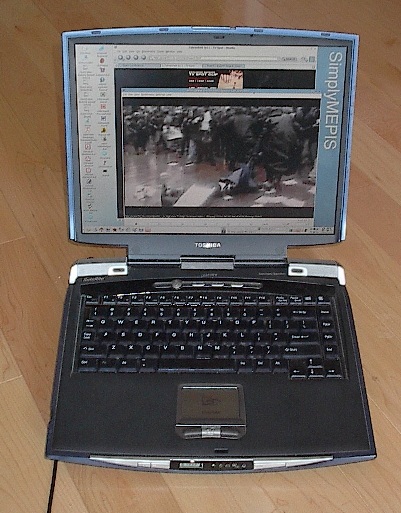
Mepis Linux Hints
Gordon Cormack
The original source for this page is at http://plg.uwaterloo.ca/~gvcormac/mepis.html
Mepis Linux
Mepis is a Debian-based "Live boot and installation and
wonderful desktop" all in one CD. If you've never heard of it, I seriously
suggest you check it out. I have it running on my laptop: a Toshiba 5200.
I've installed Mepis on an Averatec 3250HX-01, and on another Toshiba laptop and an grey-box Athlon system.
I no longer recommend MEPIS. Try Kanotix instead.
Installation
Just slap in the disk and boot from it. Try it out for a while, and then
click the "Install Icon". You'll have to resize your Windows installation,
which is done with a few clicks. Then the easiest thing to do is to let
Mepis install itself on the remainder of the disk. (I chose to leave 40GB
unallocated and to force a 1GB swap partition to be created.)
Lots and lots of stuff "just works" immediately on installation. Here's
a list of things that don't: wmv files, encrypted CDs.
Package Manager
Since this is a Debian installation, apt-get can be used to download new
stuff. The first thing I suggest you apt-get is "synaptic" - a nice gui
front-end to apt-get. To do this:
apt-get update
apt-get install synaptic
Once that's done you can use start->system->synaptic to launch the
package manager which has nice things like "search". Some of the
paths to repositories need to be fixed but you can safely say "ok" to
the error messages for now.
Sound
Sound drivers get installed properly but you may hear only silence. That's
because a number of inputs/output are disabled by default. To enable them,
run
alsamixer
Use this primitive tool to enable various inputs/output. In particular,
"external amplifier" and "pcm input" and "cd input".
Several of the applications (xine, xmms, ...?) may give really bad sound -
dropouts, distortion, noise. This can be corrected by configuring their
audio settings to use the alsa driver.
divx, wmv, etc.
Find "essential-20041107.tar.bz2" (or a later version) and install them.
I had trouble figuring out exactly where to put them but I think that copying
them all to /usr/lib/win32 was what did the trick.
Find libdvdcss and install it. I did so from source, but I think one of the
package sources that doesn't work properly is meant to have it. In any event,
my system's synaptic package manager shows "libdvdcss2" as being available.
This lets members of the as-yet-free-world play commercial DVDs.
Windows Apps
Crossover Office runs IE, Office XP, Acrobat, Photoshop, Legacy, and other
apps. straight out of the box.
DVDShrink
A very useful Windows app,
DVDShrink requires some fiddling but is well
worth it. It allows you to re-author DVDs so as to fit them (by deleting, cropping, and compressing) onto a DVD+/-R.
You can install it just fine using Crossover Office (or the regular Wine) but
when you run it you'll find that the file finder hangs up and therefore you
can't open a file with DVD VOB files in it. So you try to open a DVD and
it says "no aspi device found."
A partial is to add this to the Wine config file (~/.cxoffice/dotwine/config):
[AppDefaults\\DVD Shrink 3.2.exe\\Version]
"Windows" = "winxp"
If you first click "CD" on the Mepis desktop, and then launch DVDShrink,
you'll be able to open the DVD drive. When you're done, you'll want to
save the ISO image someplace. Don't try to use the finder to navigate -
just type the pathname for the ISO file in the text box. Then you can
burn the DVD with start->multimedia->k3b.
Finally, if you must use DVDShrink on a directory rather than the DVD device,
you can supply the (windows) pathname for the directory on the command-line:
wine DVD\ Shrink\ 2.3.exe z:\\tmp\\foo
This would open a DVD file structure at /tmp/foo.
MPEG2-VCR
If you want to edit DVD or other mpeg video, you must get
Womble MPEG-VCR.
It is the only editor I know of that lets you quickly edit
(cut, copy, paste) from multiple mpeg sources and build a combined result.
No need to transcode, either on input or output. You can scan an entire
video as fast as you can drag the cursor, cut/copy/paste with single-frame
precision, and do single-frame still capture.
For example, if you capture a TV show, you can find and edit out the
commercial breaks in a couple of minuts, and then it takes only several
minutes more to write the result as an mpeg. MPEG-VCR is a Windows
application but it runs flawlessly on Wine.
I'm not aware of any native Linux software (or any free Windows software)
that matches this functionality. Kino is a good video editor, but it works
only with DV format. So you'd have to transcode before and after editing.
This might not be *too* lossy but it would take hours for a full-length
movie.
Other media stuff
I wasn't very pleased with the mplayer plugins for Mozilla, so I installed
kaffeine. On first use it will happily install itself as the default media
player for almost everything.
Toshiba-specific stuff
Rob Miller has a
great page on Linux on the Toshiba 5100, which is essentially the same as
mine. His Debian solution is older than my Mepis one, but I used his
hints for making the cpad, hotkeys, and video work (I use the nv video driver
so that suspend/hibernate will work).
Touchpad and Mouse Together
To be able to use your touchpad and mouse at the same time, first make the touchpad work with the touchpad
driver, then add this line to the "ServerLayout" section:
InputDevice "USB Mouse" "SendCoreEvents"
Feedback
I welcome feedback on this page. Please email me at
gvcormac@uwaterloo.ca.
Note that I refuse to obfuscate my email address. To do so is to let
the spammers control me. Instead I explore the limits of
Spam filtering
technology.
